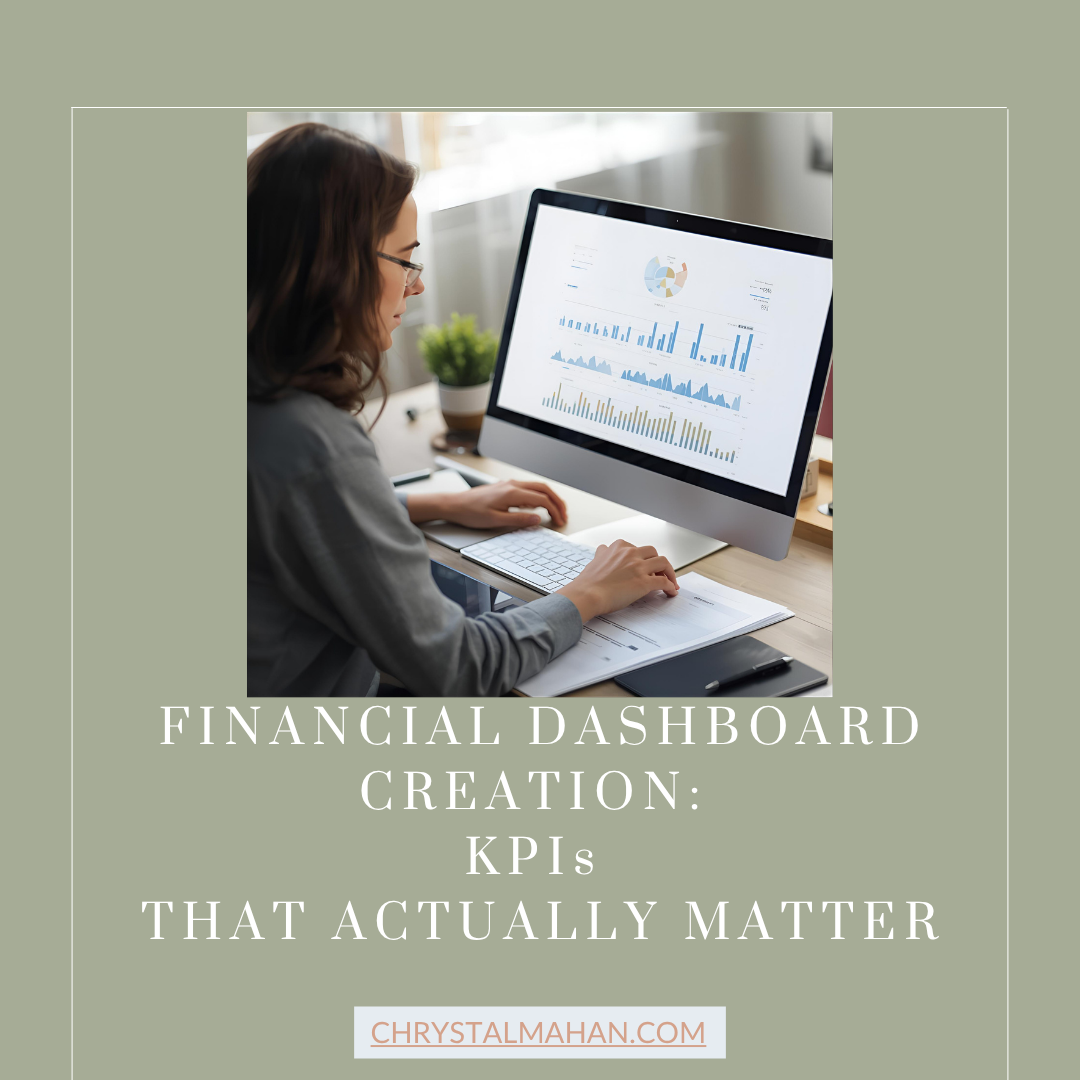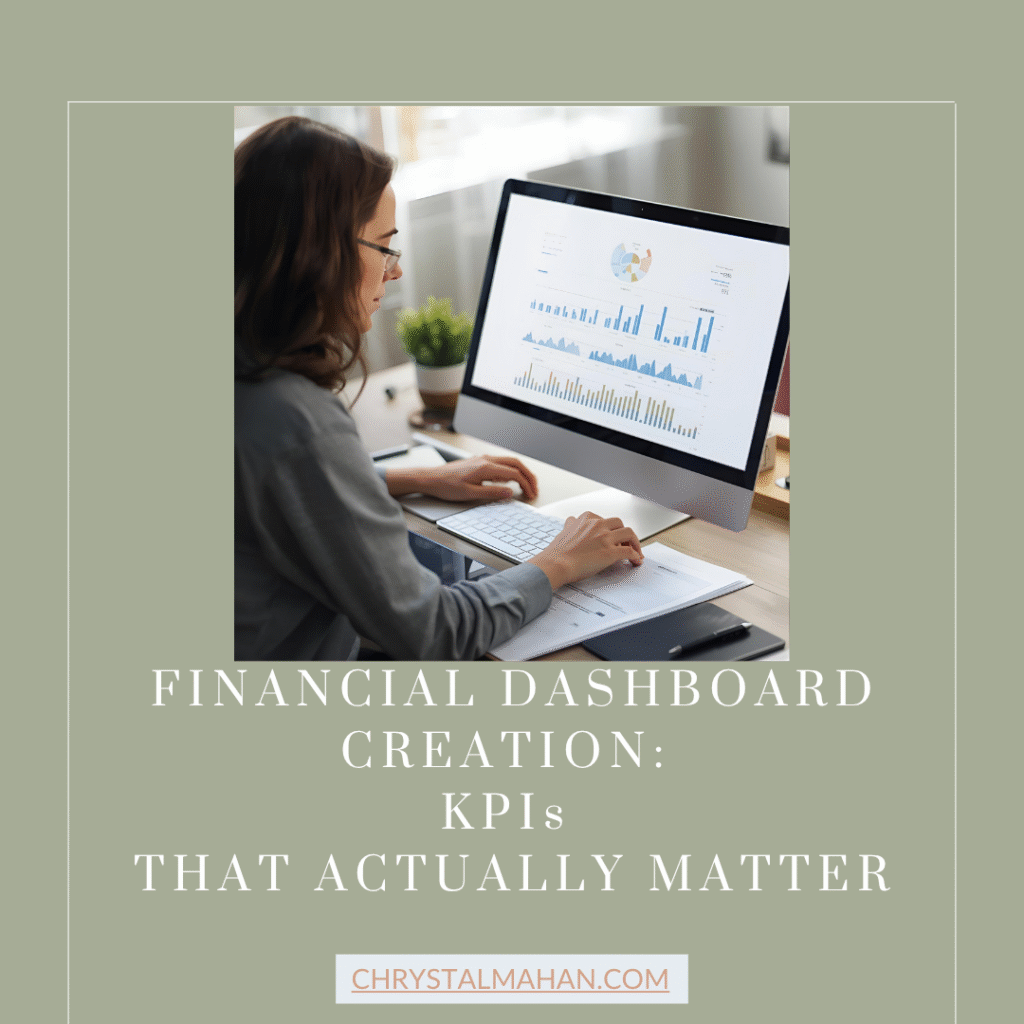Financial Dashboard Creation: KPIs That Actually Matter


Your business generates thousands of data points every single day, but most entrepreneurs are drowning in metrics that don’t move the needle. Revenue reports, expense tracking, cash flow statements, profit margins, customer acquisition costs, and dozens of other financial indicators flood your inbox and overwhelm your decision-making process. The question isn’t whether you have enough data, but whether you’re tracking the right data to drive meaningful business growth.
Consider the story of a software company that spent months perfecting a dashboard with 47 different financial metrics, color-coded charts, and real-time updates. The CEO felt confident having all this information at his fingertips until he realized that despite having more data than ever before, his team was making slower decisions and missing critical opportunities. The dashboard had become a beautiful distraction rather than a strategic tool. After working with a business consultant, they stripped their dashboard down to just eight essential KPIs that directly correlated with business success. Within six months, their decision-making speed increased by 40%, and their revenue grew by 23%.
The truth is that successful businesses don’t succeed because they track everything, they succeed because they track the right things. A well-designed financial dashboard should serve as your business compass, pointing you toward profitable decisions and alerting you to potential problems before they become crises. When you focus on KPIs that actually matter, you transform overwhelming data into actionable insights that drive consistent growth and sustainable profitability.
Revenue Metrics That Drive Growth Strategy
Revenue metrics form the foundation of any effective financial dashboard because they directly measure your business’s ability to generate income and sustain operations. However, not all revenue metrics deserve equal attention on your dashboard. The most impactful revenue KPIs provide insights into both current performance and future growth potential, enabling you to make strategic decisions that compound over time.
Monthly Recurring Revenue (MRR) and Annual Recurring Revenue (ARR) top the list for subscription-based businesses because they provide predictable income forecasting and highlight growth trends. These metrics help you understand not just how much money you’re making today, but how much you can reasonably expect to make in the coming months. For businesses without subscription models, tracking revenue growth rate month-over-month and year-over-year provides similar strategic value by revealing whether your business is gaining or losing momentum.
Revenue per customer and average order value offer deeper insights into customer behavior and market positioning. These metrics help you understand whether your growth is coming from acquiring more customers or extracting more value from existing relationships. A declining average order value might signal pricing pressure or market saturation, while an increasing revenue per customer could indicate successful upselling strategies or improved product-market fit. Tracking these metrics alongside customer acquisition numbers provides a complete picture of your revenue generation engine.
Customer Lifetime Value (CLV) rounds out the essential revenue metrics because it connects current revenue to long-term business sustainability. CLV helps you understand the total value each customer brings to your business over their entire relationship, which directly impacts how much you can afford to spend on acquisition and retention. When your CLV is increasing, it indicates that your customers are staying longer, buying more, or both, which creates a sustainable competitive advantage and improves your overall business economics.
Cash Flow Indicators for Operational Health
Cash flow metrics provide the clearest picture of your business’s operational health because they measure actual money movement rather than accounting profits. Many profitable businesses fail due to cash flow problems, making these indicators absolutely critical for day-to-day decision-making and long-term survival. The right cash flow KPIs on your dashboard will help you anticipate problems before they become critical and identify opportunities to optimize your working capital.
Operating cash flow stands as the most important metric because it measures the cash generated from your core business operations, excluding financing and investment activities. This metric tells you whether your business model generates enough cash to sustain operations without external funding. Positive operating cash flow indicates that your business is fundamentally sound, while negative operating cash flow signals that you need to either improve efficiency or raise additional capital to continue operations.
Days Sales Outstanding (DSO) and Days Payable Outstanding (DPO) provide crucial insights into your cash conversion cycle. DSO measures how long it takes to collect payment from customers, while DPO tracks how long you take to pay suppliers. The gap between these metrics significantly impacts your cash flow timing. A business with a 30-day DSO and 45-day DPO has a 15-day cash flow advantage, while the reverse situation creates cash flow pressure that must be managed through credit lines or cash reserves.
Cash runway, calculated by dividing current cash reserves by monthly burn rate, gives you a clear timeline for financial sustainability. This metric is particularly crucial for growing businesses that may be operating at a loss while investing in expansion. Knowing your cash runway helps you plan fundraising activities, adjust spending levels, and make strategic decisions about growth investments. A declining cash runway without corresponding revenue increases should trigger immediate action to either reduce expenses or accelerate revenue generation.
Profitability Analysis Through Key Performance Indicators
Profitability metrics reveal whether your business model is fundamentally sound and sustainable over the long term. While revenue and cash flow metrics show current performance, profitability indicators help you understand the efficiency of your operations and the true cost of growth. The most valuable profitability KPIs on your dashboard should help you optimize pricing, control costs, and make informed decisions about resource allocation.
Gross profit margin provides the foundation for profitability analysis by measuring the percentage of revenue remaining after direct costs of goods sold. This metric reveals the efficiency of your core operations and your pricing power in the market. A declining gross margin might indicate increased competition, rising supply costs, or inefficient operations, while an improving gross margin suggests operational improvements or successful price optimization. For service businesses, gross margin helps evaluate the efficiency of service delivery and the scalability of your business model.
Operating profit margin takes profitability analysis deeper by including all operating expenses such as sales, marketing, and administrative costs. This metric shows whether your business can generate profits from its core operations without relying on one-time gains or financial engineering. A healthy operating margin indicates that your business has sufficient pricing power and operational efficiency to sustain profitability while investing in growth. Tracking operating margin trends helps you understand whether growth investments are paying off or whether cost controls need attention.
EBITDA (Earnings Before Interest, Taxes, Depreciation, and Amortization) provides a clearer view of operational profitability by removing the effects of financing decisions and accounting methods. This metric is particularly valuable for comparing performance across different time periods or benchmarking against industry standards. EBITDA margin helps you understand the underlying profitability of your business model without the noise of capital structure decisions or depreciation policies.
Return on Investment (ROI) and Return on Assets (ROA) measure how effectively your business converts investments into profits. ROI helps evaluate specific initiatives or campaigns, while ROA measures overall asset efficiency. These metrics are crucial for making informed decisions about capital allocation and identifying areas where your business is either underperforming or excelling. High ROI indicates efficient use of capital, while declining ROA might signal that your business is becoming asset-heavy without proportional profit increases.
Customer Acquisition and Retention Financial Metrics
Customer-focused financial metrics bridge the gap between marketing effectiveness and financial performance, providing insights that drive both growth strategy and profitability optimization. These KPIs help you understand not just how much you’re spending to acquire customers, but whether those investments generate sustainable returns. The most impactful customer metrics on your dashboard should guide decisions about marketing spend, pricing strategy, and customer success investments.
Customer Acquisition Cost (CAC) measures the total cost of acquiring a new customer, including all sales and marketing expenses. This metric is fundamental because it directly impacts your business’s scalability and profitability. A rising CAC might indicate increased competition, declining marketing effectiveness, or market saturation, while a decreasing CAC suggests improving efficiency or competitive advantages. The key is tracking CAC alongside customer lifetime value to ensure that acquisition investments remain profitable over time.
The CAC to CLV ratio provides one of the most important indicators of business sustainability. A healthy ratio typically ranges from 1:3 to 1:5, meaning customers should generate three to five times more value than they cost to acquire. This ratio helps you determine how aggressively you can invest in growth while maintaining profitability. When the ratio improves, you can increase marketing spend confidently, while a declining ratio signals the need to either improve retention, increase prices, or optimize acquisition channels.
Customer churn rate and its financial impact reveal the sustainability of your growth model. While many businesses focus on gross churn percentage, the most valuable metric is revenue churn, which accounts for the varying value of different customer segments. High-value customer churn has a disproportionate impact on financial performance, making it crucial to track both overall churn and churn by customer segment. Reducing churn typically provides a higher ROI than acquiring new customers, making retention metrics essential for resource allocation decisions.
Net Revenue Retention (NRR) captures the complete financial relationship with existing customers by measuring revenue growth from the existing customer base through upsells, cross-sells, and expansions, minus revenue lost through downgrades and churn. An NRR above 100% indicates that your existing customer base is growing in value over time, which is the hallmark of successful subscription and service businesses. This metric helps you understand whether your growth is sustainable or whether you’re constantly replacing churned customers with new acquisitions.
Implementation Strategy for Dashboard Success
Creating an effective financial dashboard requires more than selecting the right metrics; it demands a systematic approach to data collection, visualization, and ongoing optimization. The most successful dashboards balance comprehensive coverage with simplicity, providing all necessary insights without overwhelming decision-makers. Your implementation strategy should focus on building a dashboard that evolves with your business needs while maintaining consistency in measurement and reporting.
Start by establishing clear data sources and collection processes for each KPI before building your dashboard. Inconsistent or unreliable data undermines the entire purpose of performance tracking, so invest time in setting up proper integrations between your accounting software, CRM, and other business systems. Automated data collection reduces errors and ensures that your dashboard reflects real-time business performance. Document your calculation methods for each metric to ensure consistency over time and facilitate troubleshooting when numbers don’t match expectations.
Design your dashboard with hierarchy and frequency in mind, placing the most critical metrics prominently and organizing information by decision-making urgency. Daily operational metrics like cash position and sales performance should be immediately visible, while strategic indicators like customer lifetime value might be reviewed weekly or monthly. Use color coding and alerts sparingly to highlight exceptions rather than normal fluctuations. The goal is to create a tool that draws attention to important changes without creating alert fatigue that causes teams to ignore genuine problems.
Establish regular review cycles and assign ownership for each metric to ensure that your dashboard drives action rather than passive observation. Monthly business reviews should include trend analysis and root cause investigation for any concerning changes in key metrics. Quarterly reviews should focus on strategic implications and potential adjustments to targets or measurement methods. Annual reviews provide opportunities to add new metrics that support evolving business goals or remove indicators that no longer provide actionable insights.
Your Financial Dashboard Foundation for Sustainable Growth
Building a financial dashboard with KPIs that actually matter represents one of the most important investments you can make in your business’s long-term success. The metrics outlined in this guide provide a comprehensive framework for understanding your business’s financial health, growth trajectory, and operational efficiency. When implemented correctly, these indicators transform overwhelming financial data into clear signals that guide strategic decision-making and drive consistent improvement.
The journey from data overwhelm to actionable insights requires commitment to both measurement discipline and continuous optimization. Your dashboard should evolve as your business grows and market conditions change, but the fundamental principles of focusing on metrics that drive decisions and outcomes remain constant. Remember that the goal isn’t to track everything possible, but to track the right things consistently and act on the insights they provide.
Ready to dive deeper into specific metrics and implementation strategies? Explore our other posts on financial management and business analytics to build your expertise in data-driven decision-making. When you’re ready to discuss your specific dashboard needs and explore how these concepts apply to your unique business situation, I’d love to join you for coffee and a strategic conversation about transforming your financial data into competitive advantages.






